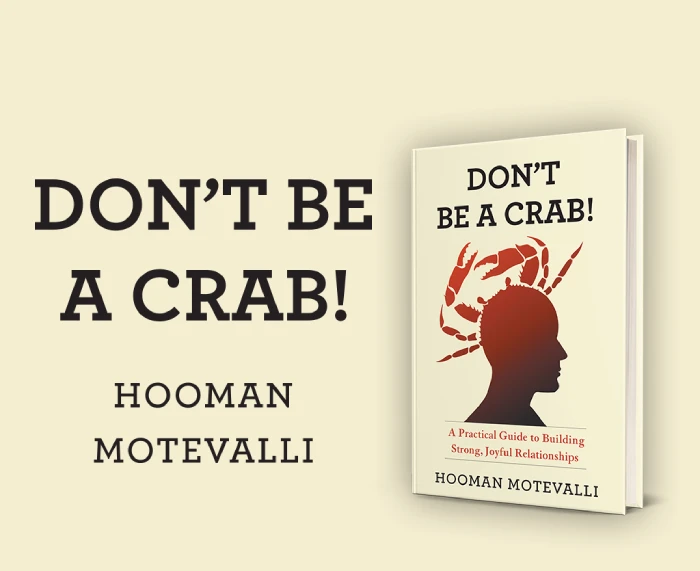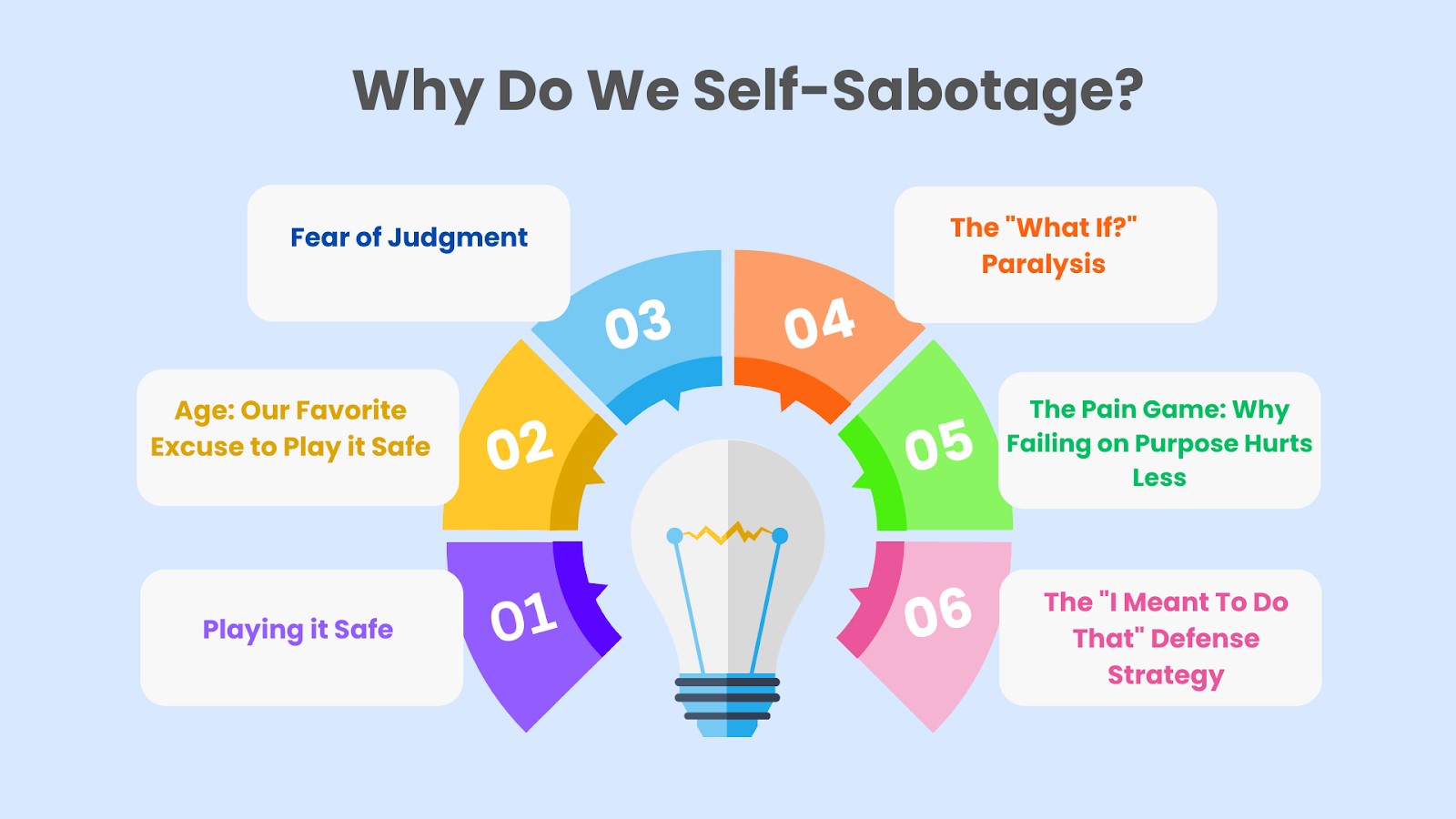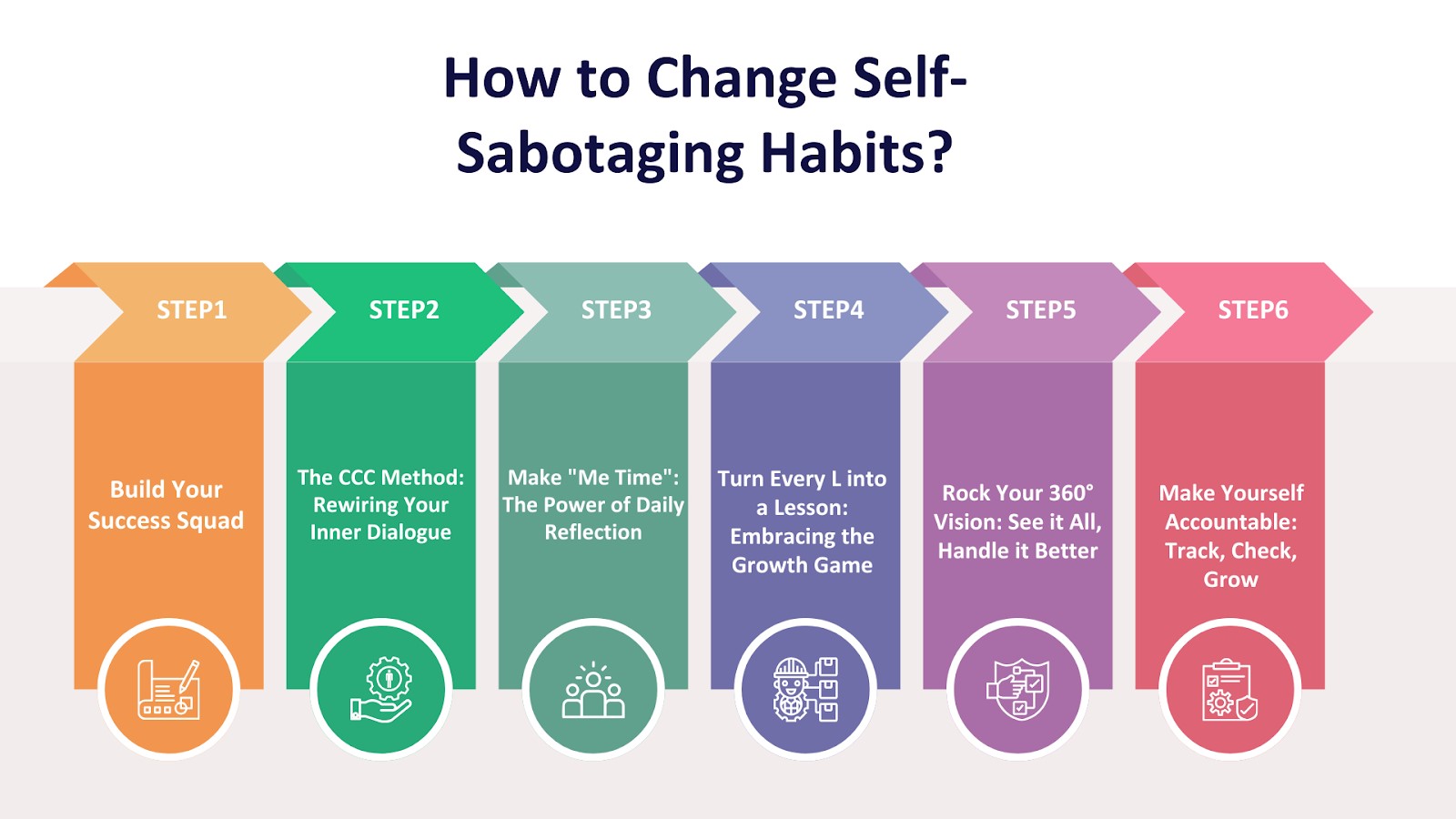About half of us are making plans to stop ourselves from doing well! Dr Ruben-Clapper’s shocking study from 2021 got it all on camera, from “forgetting” about that important meeting to losing internet connection right before important Zoom calls (sounds like something you’ve heard before, doesn’t it?).
The good news is that further research by Jakubik and Vennes in 2024 indicates we won’t have to keep engaging in activities detrimental to our self-interest. This is what happened to people who used their scientifically proven methods; they broke their bad habits in just 8 weeks. Actually, it helps people make judgments more easily and lowers the 70% frequency of self-safety undermining actions.
We are here and will help you to become your biggest fan instead of your own negative cloud. Let’s go straight to these very practical game-changing ideas without any magic cures or rocks required!
What Are Self-Sabotaging Habits?
Do you ever feel like you really want to succeed but can’t seem to shake your bad habits? It’s called self-sabotage, and it happens more often than you think! A study done by Ruben-Clapper in 2021 found that a lot of us do this, especially when big things happen in our lives, or we face difficulties.
It’s kind of like having an inner voice that tries to keep you from failing by… well, failing first. Doesn’t it sound strange? However, her study of alternative high school kids showed that about half of them had problems with these behaviours, and a lot of the time, they didn’t even know it.
According to the study, this is what self-sabotage looks like in real life:
- “I’ll start my homework tomorrow” (but tomorrow never comes)
- Skipping important classes because “what’s the point anyway?”
- Setting goals so impossibly high that you feel overwhelmed and give up
- Telling yourself, “I’m not smart enough“, even when you’re doing well
- Avoid asking for help because “I should figure it out on my own.”
- Making excuses instead of trying
- Showing up unprepared and then saying, That’s just how I am.”
The most promising thing about Ruben-Clapper’s study is that it shows us we can change these trends once we see them in ourselves. When you finally realize you’ve been putting your shoes on the wrong feet, you can fix it, and suddenly, things feel a lot better. To start, you need to be aware of when you’re getting in your own way.
Why Do We Self-Sabotage?
Studies reveal that self-sabotage usually results from rooted anxieties and habits shaped over time.
Fear of Judgment: The Hidden Protector
According to a study done by Dr. Ruben-Clapper in 2021, half of us knowingly hurt our own chances of success. Crazy, yes? The study found that students were doing common things like skipping important classes, showing up unprepared, or just “ghosting” chances.
It wasn’t that they couldn’t handle it; they just bombed on purpose because it seemed safer than trying. It’s something our brains do when we’re afraid of being judged: we’d rather watch ourselves fail than take a real chance.
Common ways to hurt yourself:
- “Forgot” to get ready for that necessary meeting? (Yes, you did…)
- “Too busy” to do the task? (Not including Netflix)
- “Something came up” before your presentation? (Yeah, panic)
- “Just wasn’t feeling it” at the gym? (For the fifth time this week)
- “Phone died” before that important call? (Classic move)
Age: Our Favorite Excuse to Play it Safe
Now look at this – Romaioli and Contarello talked to 78 people in 2018 and found that everyone was lying about their age, especially those between the ages of 35 and 49 and 75 and 84. We come up with a lot of different ways to say, “No, I’m too old for that.” According to the study, we’re not really too old; we’re just very good at avoiding being let down. And to be honest? Our only goal is to have fun.
Real Talk Examples:
- “TikTok? Nah, I aged out of that scene” (Translation: Scared to try)
- “Career switch at 40? Not happening” (Translation: Fear talking)
- “Dating apps are for the young crowd” (Translation: Avoiding rejection)
- “Can’t teach this old dog new tricks” (Translation: Won’t even attempt)
- “My learning days are behind me” (Translation: Protecting ego)
Playing it Safe: The Strategic Underdog Move
Another amazing finding from Gürtler and Münster’s 2012 study is that we sometimes hurt ourselves on purpose, and it makes perfect sense! As a result of their research, they found that people were purposely slowing down, especially when they were competing.
Think about it; have you ever noticed how some very talented staff members “drop the ball” right before they get promoted? It’s not a mess; they’re just playing chess while everyone else is playing squares. By doing this, you can escape becoming the person in the office who always gets the easy work.
Pro-Level Self-Sabotage Moves (We See You!):
- “Accidentally” missing deadlines to avoid bigger projects
- Staying quiet in meetings when you know the answer
- Playing dumb about tech skills to avoid becoming IT support
- Taking longer on tasks so you don’t get more work
- Downplaying achievements during performance reviews
The “What If?” Paralysis: When Uncertainty Hits Hard
Ruben-Clapper’s study really hit us with the truth about why we freeze up when big things happen. Her research showed that students who were going through big changes in their lives (like graduation worry!) were much more likely to get in the way of their own success.
We’re talking about 50% of alternative high school students actively sabotaging their progress when faced with uncertainty. At that point, your brain tells you “nope” and urges you to mess things up before life can mess with you.
Real-Life Uncertainty Dodges:
- Ghosting job interviews for your dream career change
- “Forgetting” to submit college applications
- Picking fights with your boss right before a promotion
- Skipping graduation prep because “what’s the point?”
- Self-destructing right before achieving a major goal
The Pain Game: Why Failing on Purpose Hurts Less
Get this: Gürtler and Münster revealed some very important information on why we could sometimes decide to fail on our own terms. Their studies revealed something really relevant: the emotional gut punch of failing despite giving it your best hurts much more than losing because you “didn’t really try.”
It’s about preserving our emotional health, even if it seems backwards. A lot of the time, people put things off or mess up on purpose to avoid that deep-down feeling of “I did everything I could and still wasn’t good enough.”
Classic Pain-Dodging Moves We All Pull:
- Waiting until the last minute to start that big presentation
- “Forgetting” to submit your work for that competition
- Not rehearsing for your performance (“I’ll just wing it!”)
- Leaving job applications until after the deadline
- Half-doing a project so you can blame the rush
The “I Meant To Do That” Defense Strategy
We’re basically emotional ninjas who build our own safety nets, which is where things get really interesting. Researchers Gürtler and Münster discovered that people choose smaller, self-inflicted mistakes over bigger, heart-breaking ones.
It’s like we’d rather watch ourselves fall than chance getting hit by something surprising. But let’s be honest; we’ve all done it; it’s made up of those ready-made reasons to protect our pride.
Self-Protective Moves We All Know:
- “I could’ve aced that test if I’d studied” (but never tried)
- “My first draft wasn’t my best work” (because you never wrote a second)
- “I wasn’t really ready for that promotion anyway” (so I didn’t even apply)
- “The timing wasn’t right” (because you made sure it wasn’t)
- “It wasn’t my priority” (because you were scared to make it one)
How to Change Self-Sabotaging Habits?
Better yet, apply these strategies to change your self-sabotaging behaviors rather than regret not being the one who could be:
1- Build Your Success Squad
Jakubik’s creative study on eight female superintendents in 2024 unearthed something exciting: Strong support systems were found among all the leaders who overcame self-sabotage.
The study found that people who met with at least three mentors every month and joined 2 or more professional groups were 3 times more likely to stop doing things that were holding them back. Having fans isn’t enough; you need to build a smart group that pushes you to grow.
8 Power Moves to Build Your Squad:
-
-
Plan bi-weekly “growth coffee” with someone who pushes you.
-
Join two to three professional groups—mix in-person and online.
-
Create a monthly mastermind with three to four colleagues from your profession.
-
Plan quarterly goal-review meetings with a mentor.
-
Make a promise to check in with someone once a week.
-
Go to business gatherings hoping to create three fresh contacts.
-
Track your network contacts on a “support spreadsheet”.
-
Plan monthly “skills calls” with many mentors.
-
To reinforce these habits and boost your inner confidence, try these 5 self-esteem exercises to help you believe in yourself.
2- The CCC Method: Rewiring Your Inner Dialogue
There are real-life examples of how the “Don’t Be a Crab” CCC method works. Within eight weeks, users who exercised all six levels—Observer through Alchemist—for only ten minutes daily reported a seventy-percent decrease in negative self-talk.
The secret is… Treat each level like a mental training program and regularly practice progressing through each one. You will go from Observer—noticing bad ideas—to Alchemist—creating good change.
8 Daily CCC Practice Steps:
- Set three daily “awareness alarms” to examine your inner chatter.
- Spend five minutes in the morning and evening keeping a “thinking journal”.
- Use the “pause-observe-respond” technique when stressed
- Practice “thought labelling” by marking each thought as helpful or not helpful.
- Make a “development evidence diary” recording your successes.
- Do two-minute “perspective changes” in response to difficulties
- Spend five minutes each day seeing yourself in five years.
- Tell a CCC friend weekly about your progress.
3- Make “Me Time” Your Secret Weapon: The Power of Daily Reflection
Amazingly, Jakubik’s 2024 study found that leaders who stopped sabotaging themselves had one daily must-do: they had to set aside time to think. These powerhouses handled their “thinking appointments” just like they would have a meeting with their manager.
They set aside 20 to 30 minutes every day, usually right before bed or first thing in the morning, to talk to themselves, think about what they did, and plan their growth. What follows? In only six weeks, 85% said their decision-making improved and their self-sabotaging habits reduced.
Your Reflective Power Motion:
- Plan a daily “thought meeting” at the same time and venue.
- Keep a journal called a “growth tracker” next to your bed.
- Set a timer for fifteen minutes of uninterrupted pure thought time—no phone!
- Apply the “3 Questions” technique: What went well? What didn’t? Then what?
- Make an annual “lessons learned” list.
- Record daily thoughts about your commute using voice notes.
- Finish any day with a “tomorrow’s game plan” session.
4- Turn Every L into a Lesson: Embracing the Growth Game
Fresh off-the-press 2024 study by Vennes delivered this reality bomb: Most school leaders (75%) were stuck in “thinking too small” mode until they learned how to deal with loss. They began treating every fall as a step forward.
For example, they wouldn’t beat themselves up when they made a mistake. Instead, they would ask, “What can I learn from this?” This change of perspective resulted in a 60% rise in approaching novel tasks and speaking out in meetings.
Your Growth Mindset Toolkit:
- Put a “lessons learnt” column in your notes app.
- Rather than “I can’t…” start sentences with “I’m learning to…“
- Share your mistakes boldly (along with the lessons you discovered).
- Save a “growth evidence” file, including earlier successes.
- Create monthly “stretch tasks” outside your comfort level.
- Celebrate small improvement steps every day (yes, daily!).
- Find a “growth partner” to share triumphs and lessons with.
5- Rock Your 360° Vision: See it All, Handle it Better
The six-perspective approach of the CCC method is not only an elegant theory but also useful for the impossible possible! Think of it as having many camera views on your life: Inner (your ideas), Outer (how others perceive you), Situational (the present scene), Out of Situation (the wider picture), Historical (what’s worked previously), and Universal (how relevant is this truly?). Users said that making decisions was 80% better when they used all six views.
Your Perspective Power Tools:
- Apply the “six-lens check” before major choices.
- Keep a “many angles” notebook for difficult problems.
- Focus on the “zoom out” method when you’re feeling worried.
- Find out, “What would my future self think?“
- Remember past victories with the reminder list.
- Build a “perspective buddy” system.
- Perform daily “viewpoint shifting” exercises.
6- Make Yourself Accountable: Track, Check, Grow
This shocking truth was revealed in Vennes’s research: Of the women who broke their self-sabotage patterns, 85% regularly had accountability check-ins. What’s the secret? Combining quarterly deep dives with weekly progress monitoring. Not only did these powerful people set goals, but they also made ways to keep track of them.
Your Accountability Arsenal Is:
- Schedule weekly “progress pulse” checks.
- Design a “success metrics” tracking system.
- Find a buddy to hold you accountable for calls every two weeks.
- Set aside monthly “target alignment” meetings.
- Track everyday victories with a habit-tracking app.
- Join a mastermind group for monthly meetings.
- Plan quarterly “progress report” events.
Conclusion: The Path to Freedom from Self-Sabotage
You don’t have to be perfect to break these bad habits. What matters is that you are aware of them and take small steps toward better choices every day. Every stride forward matters, even the uncertain ones. This is true whether you’re finally letting yourself enjoy those little wins, seeing your inner reviewer for what it is, or building your power team of fans. It’s easier to learn how to dance than to climb a mountain when you stop sabotaging yourself.
FAQs
Why Self-Compassion Helps in Changing Habits?
Treat self-compassion as your brain’s reset button while attempting to break bad behaviors. Instead of beating yourself up over mistakes (which makes us more inclined to self-sabotage), being compassionate to oneself gives mental room for improvement. Treating yourself like a friend makes you more likely to overcome setbacks and go ahead.
How to Replace Self-Sabotaging Habits with Positive Ones?
You must install new patterns and delete old ones to overcome self-sabotage, like changing your phone’s operating system. Start by recognizing self-sabotage (like putting off before large presentations) and then create a specific substitute action (like dividing the activity into 5-minute segments).
Why Do Our Old Habits Keep Coming Back?
Habits are like well-worn trails in your brain’s garden. Your previous self-sabotaging behaviors form deep grooves in your head, so when you’re anxious or fatigued, you fall back into them. You’re not failing—your brain is efficient! Instead of fighting these old pathways, establish and reinforce new ones until they become your brain’s preferred route.









